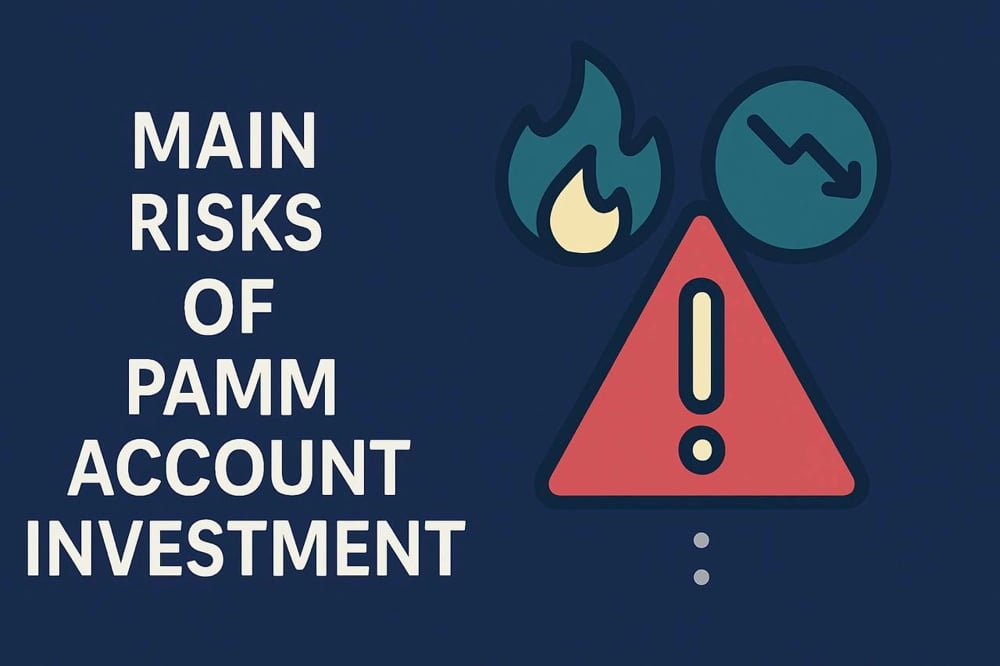Main Risks of a PAMM Account Investment
PAMM (Percentage Allocation Management Module) accounts offer a convenient way to delegate trading to professional managers. However, like any financial instrument, they come with specific risks that must be clearly understood before committing capital. Below is a structured breakdown of the most critical risk factors that every investor should consider before investing in PAMM accounts.
Manager Performance Risk
The core of any PAMM system is the trader managing the funds. While some managers demonstrate consistent performance, others may engage in overly aggressive strategies or experience significant drawdowns due to poor market timing or mismanagement.
It's important to remember that even a historically profitable strategy does not guarantee future gains. Performance can fluctuate sharply, especially in volatile markets, and losses may quickly accumulate.
This issue is analyzed in more detail in our article on whether PAMM accounts are profitable.
Exposure to High Drawdowns
Drawdown risk is among the most underappreciated threats in PAMM investing. Even when long-term returns look positive, large interim losses can devastate capital — particularly if the investor enters at the wrong moment.
Excessive drawdowns often reflect a lack of risk management, which can result in permanent capital loss.
Legal and Regulatory Ambiguity
Many PAMM accounts are hosted by offshore brokers, which often operate outside the reach of strict regulatory oversight. This presents serious concerns about fund safety, dispute resolution, and investor protection.
In jurisdictions where PAMM services are legal, the framework may still lack clear enforcement mechanisms. Before investing, it’s important to assess the legal status of PAMM accounts in your country or broker's jurisdiction.
Limited Transparency from Managers and Platforms
Unlike managed funds in traditional finance, many PAMM systems do not require full disclosure of trading strategies, open positions, or portfolio exposure. This makes it difficult for investors to evaluate risk in real time or understand how their funds are being used.
The limited transparency can leave investors exposed to strategies they would otherwise reject. Our article on whether PAMM accounts are safe provides further insights into these structural limitations.
Delayed Withdrawals and Liquidity Constraints
Some PAMM platforms impose restrictions on fund withdrawals, particularly during high-volatility periods or trading lock-ins defined by the manager.
Investors should be aware that their funds may not be immediately accessible when market conditions deteriorate. Withdrawal delays, fee penalties, or settlement periods may significantly reduce flexibility.
Conflicting Incentives Between Managers and Investors
In many PAMM setups, managers are rewarded with performance fees that are calculated based on short-term gains. This structure can create an incentive to pursue high-risk, high-reward strategies rather than sustainable long-term growth.
In extreme cases, managers may even use excessive leverage or concentrate trades to maximize fee income — a practice that directly increases investor risk.
Technical Failures and Platform Errors
Operational risks such as execution delays, inaccurate profit distribution, or synchronization failures between manager and investor accounts are often overlooked but can lead to real financial losses.
Because the investor has no control over trade execution, even a minor technical failure on the broker’s side can result in capital exposure or lost opportunities.
Complete Lack of Investor Control
Once funds are allocated, investors cannot interfere with or override trades. There’s no ability to hedge, modify positions, or set personal stop-losses.
This lack of control means you are fully reliant on the manager's judgment and risk practices, which may not align with your personal risk tolerance.
Before choosing to invest, it's critical to understand the fundamental mechanics of such systems — start by reviewing our beginner-oriented article: What is a PAMM account?
Final Thoughts
PAMM accounts are not inherently dangerous, but they do require a deep understanding of the underlying risks. Investors should vet managers carefully, examine legal protections, and evaluate the structure of the broker’s platform.
Blind reliance on past performance or promotional material can be costly. A risk-aware approach — including reviewing whether PAMM accounts are safe or profitable — will help you make informed, strategic decisions in this complex space.
FAQ: PAMM Risk Insights
What is a PAMM account in trading?A PAMM account is a structure where investors allocate funds to a trader (manager) who trades on their behalf. All profits and losses are distributed proportionally. Learn more in What is PAMM in trading?
What’s the biggest risk of investing in a PAMM account?The main risk is the manager’s trading behavior. Even experienced traders can suffer large losses due to poor decisions or unexpected market movements.
Are PAMM accounts legal and regulated?PAMM accounts are legal in many countries, but the level of regulation depends on the broker’s jurisdiction. Investors should understand the legal status of PAMM accounts in their region.
Can I lose all my funds in a PAMM account?Yes. If the manager uses high leverage or engages in reckless trading, total loss of capital is possible.
Are PAMM investments profitable enough to justify the risk?That depends on the manager and the investor's risk tolerance. Our full guide on the profitability of PAMM accounts explains when and why they may be worth considering.









Comments
The implications for automation extend well beyond this deal, signaling long-term disruption